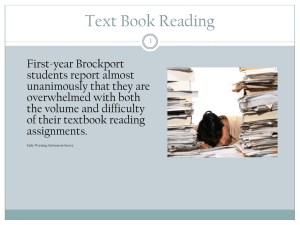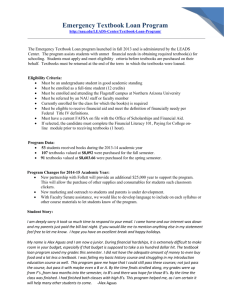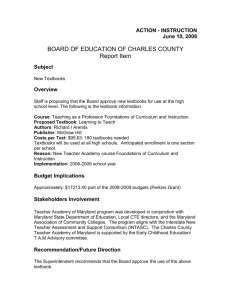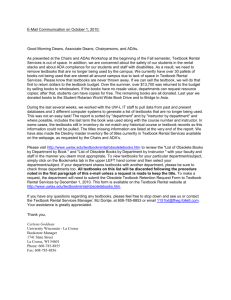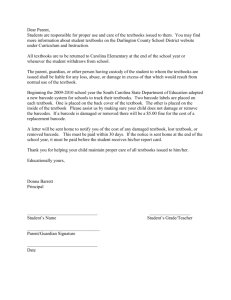Traditional Textbook Alternatives
advertisement
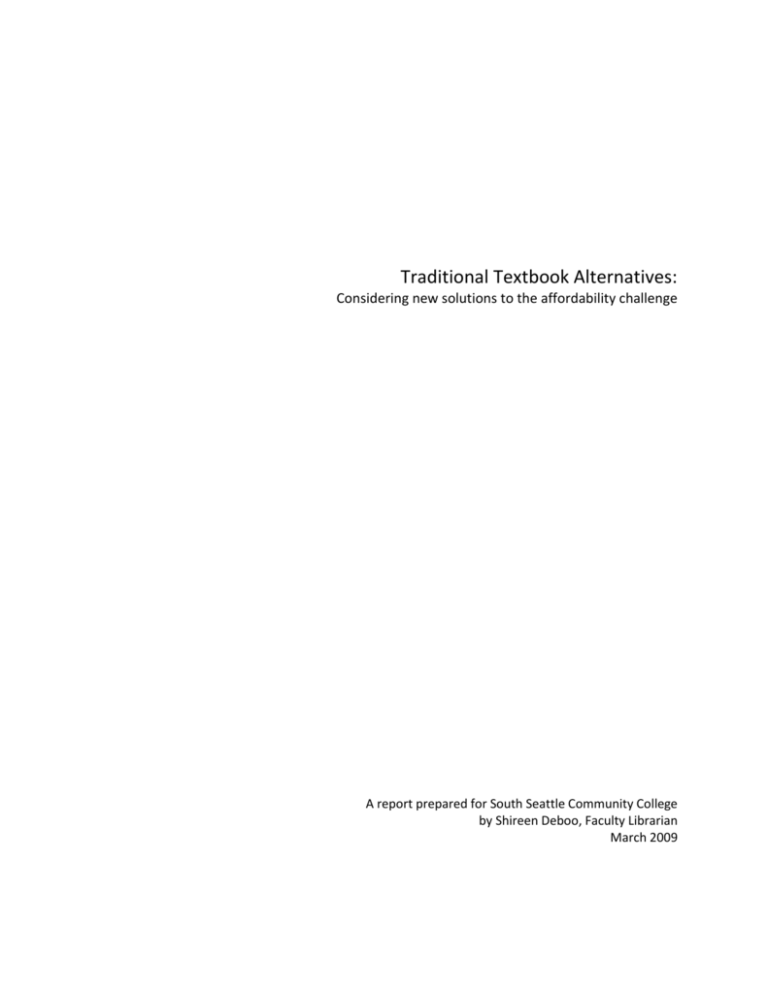
Traditional Textbook Alternatives: Considering new solutions to the affordability challenge A report prepared for South Seattle Community College by Shireen Deboo, Faculty Librarian March 2009 The Current Situation The cost of course textbooks has long been a source of financial anxiety for college students. But in the past half decade, prices have become increasingly prohibitive, and that anxiety is affecting parents, teachers and administrators. Students of two-year public colleges spend, on average, $850 a year on textbooks.1 The cost of the average college textbook increased 186 percent between 1986 and 2004.2 Expensive textbooks can significantly increase the cost of enrolling at a college, especially for students with limited incomes. Some may choose to take courses with no textbook requirements. Other traditional options, such as finding a used edition or getting a library copy, may delay access to the material and affect a student’s ability to keep up with reading assignments in a timely manner. These alternatives often lead to students using an older edition of the book, which may not have the same content as an instructor’s assigned text. Concern about textbook costs has led to efforts on the state and federal legislative level. Seventeen states, such as Virginia and Connecticut, have recently proposed legislation to help curb the rising costs of books, including the requirement that schools post the international barcode number of each of the required texts so that students can comparison-shop online. The new Connecticut law also would require publishers to tell professors what the books cost before the professors assign their students to buy them.3 In July of 2010, a federal law, the Higher Education Opportunity Act, will include a textbook provision intended to regulate some publisher activity. Section 112 of the Act requires price disclosures and unbundling of packaged content. Here in Washington state, two bills are alive in the legislature that address textbook costs, and the State Board for Community and Technical Colleges has adopted a Strategic Technology Plan that proposes a policy of eliminating published textbooks in favor of free, online materials when possible. Meanwhile, a range of alternatives are being developed by students, faculty, administrators and publishers. Responses to the challenge Three different communities are taking proactive steps in responding to this problem: the commercial sector, which sees an opportunity to profit by offering lower-priced alternatives to frustrated students; and the “open source” community—students, educators, librarians, and others—which operates on the 1 “Tennessee Bill Seeks to Reduce Cost of College Textbooks,” Community College Week 18 June 2007: 21, 24 Feb. 2009 Academic Search Premier. EBSCO. South Seattle Community College Library. <http://p2048-ez.sccd.ctc.edu.ez.sccd.ctc.edu:4048/ login?url=http://search.ebscohost.com/login.aspx?direct=true&db=aph&AN=25482646&site=ehost-live>. 2 Alex Kingsbury and Lindsay Galloway, “Textbooks Enter the Digital Era; High-tech Options can Save Money and Boost Learning,” U.S. News and World Report 16 Oct. 2006, 25 Feb. 2009 ProQuest Research Library. ProQuest. South Seattle Community College Library. <http://proquest.umi.com.ez.sccd.ctc.edu:2060/qdweb?did=1142735051&sid=1&Fmt=3&clientId=79571&RQT=309&VName=PQD>. 3 Kingsbury and Galloway. 2 philosophy that the Internet should facilitate free access to educational content. In addition, college librarians’ information literacy initiatives have helped incorporate inquiry-based pedagogies that limit reliance on textbooks and better leverage existing library resources. The efforts of these sectors have resulted in a number of alternatives to traditional textbooks, which are explored below. Textbook Rentals Rental programs can be initiated and operated through campus bookstores, external private companies or other agencies. They are funded through campus fees, course fees, student associations, or book rental charges. Colleges may choose to develop self-sustaining rental programs, or to subsidize the programs to lower rental rates for students. Alternatively, rental programs can be operated by the campus bookstore. Currently less than 3% of college bookstores offer rental programs.4 Rental programs can start with courses that have high enrollment and increase offerings over time. Students who choose to may continue to purchase books. Students typically spend about one-third as much on rentals as they would on standard textbook purchases. For the campus bookstore, textbook rentals reduce the hassle of returns. Rentals are 60% cheaper than full price purchases, and for students who don’t intend to keep the books, they prevent the need to sell back the items. For those who choose to purchase a rental textbook later, the rental fee is credited towards the full purchase price. There are disadvantages to consider as well. The savings from renting a textbook are about the same as buying a used textbook, and some students may prefer that option. From a management perspective, rental programs need to have adequate space to store texts quarter to quarter and texts that remain unrented. (At South, the estimated storage space needed would be 500 square feet.) Instructors must commit to using the same materials, usually for at least two years in order to make the program work. Because they are rented, the books cannot be excessively marked, highlighted or inscribed with notes. This may limit their appeal to students. Establishing a rental program on campus also involves start up costs including purchasing inventory, securing and organizing storage space, and developing a computer tracking system. The University of Illinois at Chicago estimated that a rental program would cost the institution 12% more than they spend on their existing retail program.5 Costs incurred by South may be much lower if the campus bookstore commits to beginning its own rental program in the fall of this year, as they currently expect to. Textbook rental programs may dent publishers’ profits to some extent, but they are not a direct threat to the traditional model of textbook purchases. Rather, they represent a moderated response to the problem. Students see some savings, and publishers still see profits. Digital Textbooks Digital textbooks are offered by both the commercial sector and the open source community. Digital textbooks offer a number of advantages to students and instructors. Depending on the product, 4 National Assocation of College Stores. National Association of College Stores. 2009. 2 Mar. 2009 <http://www.nacs.org>. 5 Illinois Board of Higher Education. Report on Textbook Rental Study. 65-70. Illinois Board of Higher Education. 1 Feb. 2005. 26 Feb. 2009 <http://www.ibhe.state.il.us/Board/Agendas/2005/February/Item%2010.pdf>. 3 content may be searchable, customizable, easily updated, and can include video and audio features. Digital textbooks save paper, and most importantly, are available from any connected computer. Commercial vendors of digital textbooks include Kinetic Books, CourseSmart, and Vital Source. Kinetic is a small, private Seattle-based outfit which offers a limited number of titles in math and science. CourseSmart is a joint effort of five major corporate textbook publishers including Wiley and McGrawHill, and offers over 5,400 titles in every discipline on its website. Vendors may offer downloads, CD packages, or online access with printing privileges. CourseSmart appears to be the market leader for commercial digital textbooks. Their product is essentially a subscription, or rental, with full online access to a textbook for a limited time period. The product is designed to limit sharing or duplicating, and a study produced by a coalition of student interest groups argues that products like CourseSmart’s do not really represent a cost savings to students because the subscription formula prevents students from recovering any portion of the textbook cost through a resale. 6 Furthermore, students don’t even have permanent access to their texts through such a service, and instructors cannot modify content. Although some sources suggest a savings of up to 60% from traditional print textbooks, an anecdotal review of prices on these sites found texts ranging from $25 to over $200. Despite the access limitations and the meager savings, many colleges have adopted commercial digital textbooks on their campuses, including Portland Community College, Louisiana State University—Baton Rouge, and Cal State Fullerton.7 The website of Kinetic Books lists over four dozen higher education institutions using their products. The flexibility of online content has helped generate a more creative set of digital textbook alternatives as well. These may be considered hybrids of commercial and open access offerings, and are offered by non-profit coalitions as well as commercial vendors finding different ways to generate revenue and still serve students equitably. Because the materials are less proprietary, there is usually more flexibility in how materials are accessed. Many items have a Creative Commons copyright, allowing for open re-use and reproduction. Texts may be downloaded as PDF documents, linked to faculty course pages, printed or saved on student drives. Free digital textbook providers include Textbook Revolution, Book Boon, Flat World Knowledge and Textbook Media. Textbook Revolution is a student-run, volunteer based wiki, with links to dozens of titles in all areas of study. Some subjects have fairly limited choices, while others offer a longer list of titles. Texts are offered to the site by professors or independent authors. Because anyone can add to this site, quality and consistency may be factors that instructors must consider more closely before assigning materials from the site. Textbook Media (Freeload Press) operates with a different model. They license content from participating college textbook publishers, and make online access available through free registration and 6 Calpirg Education Fund. Affordable Textbooks for the 21st Century: A Guide to Establishing Textbook Rental Services. Make Textbooks Affordable. Campaign to Reduce College Textbook Costs. 2 Mar. 2009 <http://www.maketextbooksaffordable.org/rental_report.pdf>. 7 Andrea Foster, “In a Pilot Project, Ten College Bookstores Begin Selling Digital Textbooks,” Chronicle of Higher Education [Washington, D.C.] 2 Sept. 2005: Vol. 52, Iss. 2; pg. A.45. ProQuest Research Library. ProQuest. South Seattle Community College. 25 Feb. 2009 <http://proquest.umi.com.ez.sccd.ctc.edu:2060/pqdweb?did=906780371&sid=1&Fmt=3&clientId=79571&RQT=309&VName=PQD>. 4 sponsor advertising. Only limited printing is available for the free version of the text, so students can choose from a variety of “upgrade” options: $10 for online ad-free text, $15 for a PDF download, or $40 for an ad-free paperback. Because the material is licensed from textbook publishers, there is some control over editorial quality. While Textbook Media offers reasonable prices and free content for students, their inventory is currently very limited; only about thirty titles are listed on their site. Flat World Knowledge also has a limited number of titles presently: about three dozen focused on business, finance and marketing. Access is free online, with additional fee-based options like PDF printouts. Flat World controls what textbooks are made available through their site, so quality and content are managed and consistent, but may reflect limited viewpoints. Instructors have the ability to customize from the texts available, adding or dropping chapters, for example, and making links available through their course management software or websites. Open Courseware Open courseware can be regarded as the result of creative academic communities maximizing the potential of the web as a collaborative educational medium. Open courseware innovations are typically a partnership amongst educators or educational institutions, supported through foundations and universities, and built on the principle that knowledge and education thrive when they are shared, open pursuits. They generally operate on an open license or Creative Commons model. Open courseware sites are robust and comprehensive, offering much more than digital textbooks. Content might include the full suite of materials from a college instructor’s courseload: syllabi, lecture notes, slides, reading lists, video links, study notes, and more. Some of the most prominent and actively used open courseware models include MIT Open Courseware, MERLOT, Connexions, and OER. Open Education Resources (OER) allows educators to share, use and alter classroom materials which are browsable by subject area or searchable through a site-based search engine. OER includes primary and secondary education materials as well as higher education resources. Most materials have a Creative Commons license, and textbooks are peer-reviewed before being added to the site. Because it’s an open access site, and because anyone can add content, consistency and quality of materials is a factor. But OER also allows users to rate and “tag” materials, thereby creating an informal peer-review of all online content. Connexions is another early leader in the open courseware community. It was developed at Rice University, supported by private foundations, educational institutions and government, and administered by an oversight board and paid staff. Connexions includes content at all levels, not just higher education, and requires that material be added to the site in “modules” that they define as nonlinear “knowledge chunks”. The site includes hundreds of modules in all disciplines. Because anyone can contribute material, instructors are responsible for screening and evaluating content before including it in their course offerings. MERLOT (Multimedia Educational Resource for Learning and Online Teaching) materials are limited to the higher education level and are subject to peer-review evaluation before being added to the open access site. MERLOT’s institutional support and partnership comes primarily from California State University and over a dozen other state colleges and universities. Users can browse for materials by subject, and find open texts, lectures, notes and more, all with peer review ratings and information about the author. It’s important to understand that the focus of sites like MERLOT is teaching resources, 5 not necessarily textbooks. This doesn’t necessarily reduce their value as a possible part of the solution, but should be recognized as more than just another version of a textbook. Library Resources and Inquiry-based learning Increasingly over the past decade or more, college libraries have been developing an approach to information literacy that incorporates inquiry-based learning across the curriculum. Many instructors are recognizing that textbooks are not a “real world” method of gathering information; many colleges (like South) have identified information literacy skills (the ability to find, use and evaluate appropriate information) as a critical student learning outcome. By collaborating with faculty across disciplines, libraries help locate relevant resources for student use, teach students how to access those resources and how to develop critical analysis skills that will transfer to future goals. These services, when successfully integrated into courses, can protect students from some textbook expenses while enhancing the skills they take to the workplace, further education and beyond. Of course, in addition to collaborative instruction models, the library also offers a number of textbook alternatives: print and electronic course reserves, late edition textbooks for circulation, and a periodical and book collection that reflects campus instructional programs and goals. 6 Recommendations Continue to pursue legislative efforts to manage and address the costs of textbooks. The faculty union and the administration should coordinate with their partners statewide to develop a uniform strategy for working with legislators, suggesting appropriate measures and advocating for student needs on this issue, while recognizing that commercially-published textbooks will always be a product that colleges have limited ability to control. Carefully monitor the costs and benefits of the textbook rental program as it is established at South in the fall 2009 quarter. Develop a campus culture that embraces open access e-learning resources: Offer faculty workshops on sites like MERLOT and Connexions. Establish a cross-campus committee to develop best practices and guidelines for e-textbook resources at South. Encourage departments to identify open access texts or materials that meet the academic and instructional criteria determined by their faculty, especially for high enrollment courses Provide faculty release time to review and evaluate online materials and identify items appropriate for South courses. Link to e-learning sites from the library, college home page and course websites. Recognize the library as a partner for identifying, evaluating and accessing alternative resources. The library can offer: A repository of textbooks and textbook options Leadership in identifying authoritative sources E reserve and print reserve services Links to additional sources Resources on copyright and creative commons questions Embedded services in online courses 7 Textbook Alternatives: A comparison matrix Resource Price range Benefits Drawbacks Notes Print textbooks for sale $75-$175 Familiar model. Known, reputed authors. Expensive. Represents only one media format. Cannot be altered or customized. Constantly updated and outdated. Represents only one media format. Cannot be altered or customized. Instructors must commit to same text for multiple quarters. Significant start up costs for the institution unless managed by bookstore entity. Cost savings questionable. Students are essentially renting the product and cannot sell it back to limit the cost outlay. Limited flexibility in customizing content. Quality, content and authority of materials is inconsistent because of varying or limited publishing standards. Long term goal should be to phase out by offering increasing number of alternatives. Print textbooks for rent Familiar model. Known, reputed authors. Cheaper option. Commercial digital textbooks $25-200 Multimedia format may include sound and video content. Familiar publishers. Open access digital textbooks $0-50 Free. Flexible copyright standards. Multimedia format may include sound and video content. May be customizable. Open courseware Free Free. Multimedia offerings. Flexible copyright standards. Customizable content. Materials available include lecture notes, syllabi, visuals, etc. Library Resources Existing part of budget Collection reflects instructional goals and faculty priorities. Information literacy (IL) is a student learning outcome on campus; use of library resources incorporates IL skills while providing instructors and students with relevant course materials. 8 Quality, content and authority of materials is inconsistent because of varying or limited publishing standards. Focus is more on instructional content than on student materials. For some faculty, increased use of and collaboration with the library requires a shift in pedagogy or course planning. Worth considering as a part of the short-term solution, but does not offer the savings and flexibility of open access eresources. Savings are about the same as buying a used print textbook. Possible savings and enhanced formats ultimately are not worth the investment in researching and establishing this option on campus. Essentially replaces the expensive textbook problem with an expensive ebook problem. This alternative offers many advantages but should be approached with a careful evaluation and selection strategy developed by instructors, library faculty and administration. This alternative offers many advantages but should be approached with a careful evaluation and selection strategy developed by instructors, library faculty and administration. The library should be considered an integral partner in solutions for learning materials. References Advisory Committee on Student Financial Assistance. Turn the Page: Making College Textbooks More Affordable. U.S. Department of Education. May 2007. 26 Feb. 2009 <http://www.ed.gov/about/ bdscomm/list/acsfa/turnthepage.pdf>. Calpirg Education Fund. Affordable Textbooks for the 21st Century: A Guide to Establishing Textbook Rental Services. Make Textbooks Affordable. Campaign to Reduce College Textbook Costs. 2 Mar. 2009 <http://www.maketextbooksaffordable.org/rental_report.pdf>. The Cape Town Open Education Declaration. 11 Mar. 2009 <http://www.capetowndeclaration.org/>. Connexions. Rice University. 2 Mar. 2009 <http://www.cnx.org>. CourseSmart. CourseSmart. 2008. 2 Mar. 2009 <http://www.coursesmart.com/>. “Digital Textbooks Debut at Missouri.” Tulsa World 9 Nov. 2008: A.21. ProQuest Newspapers. ProQuest. South Seattle Community College Library. 26 Feb. 2009 <http://proquest.umi.com.ez.sccd.ctc.edu:2060/ pqdweb?did=1594457571&sid=1&Fmt=3&clientId=79571&RQT=309&VName=PQD>. Farren, Julie. “Textbook Rentals Hailed: San Bernadino College is the First in the Area to Offer Such a Program.” Press-Enterprise [Riverside, CA] 25 Jan. 2009: C9. ProQuest Research Library. ProQuest. South Seattle Community College Library. 24 Feb. 2009 <http://proquest.umi.com.ez.sccd.ctc.edu:4048/ pqdweb?did=1633887521&sid=1&Fmt=3&clientId=79571&RQT=309&VName=PQD>. Flat World Knowledge. Flat World Knowledge. 2009. 2 Mar. 2009 <http://www.flatworldknowledge.com/>. Foster, Andrea. “In a Pilot Project, Ten College Bookstores Begin Selling Digital Textbooks.” Chronicle of Higher Education [Washington, D.C.] 2 Sept. 2005: Vol. 52, Iss. 2; pg. A.45. ProQuest Research Library. ProQuest. South Seattle Community College. 25 Feb. 2009 <http://proquest.umi.com.ez.sccd.ctc.edu:2060/ pqdweb?did=906780371&sid=1&Fmt=3&clientId=79571&RQT=309&VName=PQD>. Freeload Press. Freeload Press. 2 Mar. 2009 <http://www.freeloadpress.com>. Green, Cable. Telephone interview. 17 Feb. 2009. Gross, Sylvia Maria, rept. “Paper Cut: Missouri College Embraces E-Textbooks.” Morning Edition. National Public Radio. 23 Feb. 2009. Transcript. National Public Radio. 23 Feb. 2009. 26 Feb. 2009 <http://www.npr.org/templates/story/story.php?storyId=99961163>. 9 Holland, Gale. “California push could jolt open-source textbooks into wider acceptance.” Community College Week 20 Oct. 2008: 7. Academic Search Premier. EBSCO. South Seattle Community College Library. 24 Feb. 2009 <http://search.ebscohost.com.ez.sccd.ctc.edu:2060/ login.aspx?direct=true&db=aph&AN=35371383&site=ehost-live>. - - -. “Digital Textbooks May Not be Cheaper, report finds; Online Versions can’t be Sold Back and may have Expiration Dates.” Los Angeles Times 25 Aug. 2008: B.3. ProQuest Newspapers. ProQuest. South Seattle Community College Library. 26 Feb. 2009 <http://proquest.umi.com.ez.sccd.ctc.edu:2060/ pqdweb?did=1540128801&sid=1&Fmt=3&clientId=79571&RQT=309&VName=PQD>. Illinois Board of Higher Education. Report on Textbook Rental Study. 65-70. Illinois Board of Higher Education. 1 Feb. 2005. 26 Feb. 2009 <http://www.ibhe.state.il.us/Board/Agendas/2005/ February/Item%2010.pdf>. Kinetic Books. Kinetic Books. 2008. 2 Mar. 2009 <http://www.kineticbooks.com>. Kingsbury, Alex, and Lindsey Galloway. “Textbooks Enter the Digital Era; High-tech Options can Save Money and Boost Learning.” U.S. News and World Report 16 Oct. 2006. ProQuest Research Library. ProQuest. South Seattle Community College Library. 25 Feb. 2009 <http://proquest.umi.com.ez.sccd.ctc.edu:2060/ pqdweb?did=1142735051&sid=1&Fmt=3&clientId=79571&RQT=309&VName=PQD>. Lamb, Gregory M. “Textbooks Built to Fit Student Budgets.” Christian Science Monitor [Boston] 18 Oct. 2008: 25. ProQuest Newspapers. ProQuest. South Seattle Community College Library. 25 Feb. 2009 <http://proquest.umi.com.ez.sccd.ctc.edu:2060/ pqdweb?did=1578789971&sid=1&Fmt=3&clientId=79571&RQT=309&VName=PQD>. Lyman, Frank. “Students Enjoy Lower Costs, Lighter Backpacks As E-Textbook Availability Expands Dramatically.” Community College Week 20 Oct. 2008: 8. Academic Search Premier. EBSCO. South Seattle Community College Library. 24 Feb. 2009 <http://p2048ez.sccd.ctc.edu.ez.sccd.ctc.edu:4048/login?url=http://search.ebscohost.com/ login.aspx?direct=true&db=aph&AN=35371384&site=ehost-live>. MERLOT: Multimedia Educational Resources for Learning and Online Teaching. 2009. 2 Mar. 2009 <http://www.merlot.org/merlot/index.htm>. National Assocation of College Stores. National Association of College Stores. 2009. 2 Mar. 2009 <http://www.nacs.org>. Nelson, Mark R. “The Cost of Textbooks is Driving Electronic Solution.” The Chronicle of Higher Education 28 Nov. 2008: Vol 29, Issue 14, A29. ProQuest Research Library. ProQuest. South Seattle Community College Library. 24 Feb. 2009 <http://proquest.umi.com.ez.sccd.ctc.edu:2060/ pqdweb?did=1614841941&sid=1&Fmt=3&clientId=79571&RQT=309&VName=PQD>. 10 OER Commons. 2007. ISKME. 2 Mar. 2009 <http://www.oercommons.org>. Orchowski, Peggy. “Congress Questions Sky-high Costs of College Textbooks.” Community College Week 16 Aug. 2004: 3-9. Academic Search Premier. EBSCO. South Seattle Community College Library. 24 Feb. 2009 <http://p2048-ez.sccd.ctc.edu.ez.sccd.ctc.edu:4048/ login?url=http://search.ebscohost.com/ login.aspx?direct=true&db=aph&AN=14154980&site=ehost-live>. Pekow, Charles. “Skyrocketing Textbook Costs Get an Ear in Washington.” Community College Week 9 Oct. 2006: 3-9. Academic Search Premier. EBSCO. South Seattle Community College Library. 24 Feb. 2009 <http://p2048-ez.sccd.ctc.edu.ez.sccd.ctc.edu:4048/ login?url=http://search.ebscohost.com/ login.aspx?direct=true&db=aph&AN=25482646&site=ehost-live>. - - -. “Technology Touted as Solution to Soaring Textbook Costs.” Community College Week 18 June 2007: 12. Academic Search Premier. EBSCO. South Seattle Community College Library. 24 Feb. 2009 <http://p2048-ez.sccd.ctc.edu.ez.sccd.ctc.edu:4048/ login?url=http://search.ebscohost.com/ login.aspx?direct=true&db=aph&AN=25482622&site=ehost-live>. “Tennessee Bill Seeks to Reduce Cost of College Textbooks.” Community College Week 18 June 2007: 21. Academic Search Premier. EBSCO. South Seattle Community College Library. 24 Feb. 2009 <http://p2048-ez.sccd.ctc.edu.ez.sccd.ctc.edu:4048/login?url=http://search.ebscohost.com/ login.aspx?direct=true&db=aph&AN=25482646&site=ehost-live>. Textbook Revolution. Textbook Revolution. 2008. 2 Mar. 2009 <http://textbookrevolution.org/ index.php/Main_Page>. Vital Source. VitalSource. 2 Mar. 2009 <http://www.vitalsource.com>. Washington State. Washington State Board for Community and Technical Colleges. Strategic Technology Plan for Washington State Community and Technical Colleges. Nov. 2008. 11 Mar. 2009 <http://www.sbctc.ctc.edu/docs/strategicplan/strategic_technology_plan.pdf>. 11



